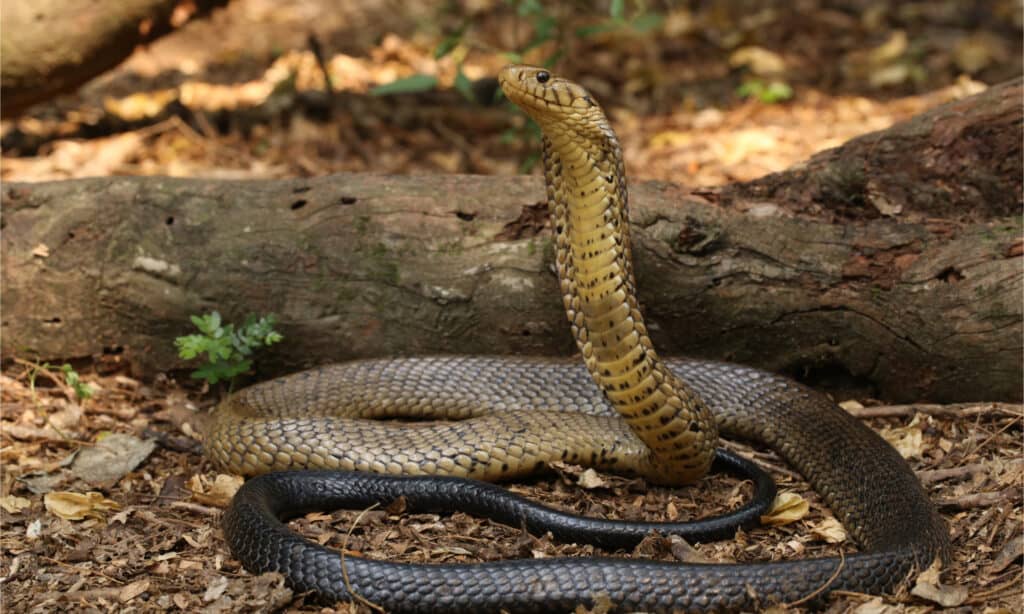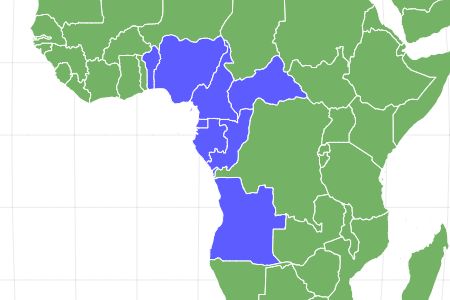Forest Cobra
.jumbotron {
background-image: url(“https://a-z-animals.com/media/2022/05/Naja-melanoleuca-400×300.jpg”);
}
}
@media only screen and (min-width: 641px) and (max-width: 920px) {
.jumbotron {
background-image: url(“https://a-z-animals.com/media/2022/05/Naja-melanoleuca-470×370.jpg”);
}
}
@media only screen and (min-width: 921px) {
.jumbotron {
background-image: url(“https://a-z-animals.com/media/2022/05/Naja-melanoleuca.jpg”);
}
}
Forest Cobra
Naja melanoleuca
There are three different color morphs, which entirely depend on the region that they live in.
Forest Cobra Scientific Classification
- Kingdom
- Animalia
- Phylum
- Chordata
- Class
- Reptilia
- Order
- Squamata
- Family
- Elapidae
- Genus
- Naja
- Scientific Name
- Naja melanoleuca
Read our Complete Guide to Classification of Animals.
Forest Cobra Conservation Status
Forest Cobra Facts
- Prey
- Insects, small mammals (including Gifford’s giant shrew), other snakes, eggs
- Fun Fact
- There are three different color morphs, which entirely depend on the region that they live in.
- Most Distinctive Feature
- A large and broad head with a hood that extends down to the neck
- Habitat
- Savannas and lowland forests
- Diet
- Carnivore
- Lifestyle
-
- Diurnal
- Common Name
- Forest cobra, black cobra, black and white-lipped cobra
Forest Cobra Physical Characteristics
- Venomous
- Yes
- Aggression
- High
This post may contain affiliate links to our partners like Chewy, Amazon, and others. Purchasing through these helps us further the A-Z Animals mission to educate about the world’s species..

Discover alligator-eating snakes, spiders larger than your phone, and 1000 more incredible animals in our daily FREE email.
.photo-gallery {
–margin: 0px auto 0px;
–padding: 0px 0px 0px 0px;
}
.gallery-link {
background-image: url(“https://a-z-animals.com/media/2022/05/Naja-melanoleuca-1024×614.jpg”);
background-repeat: no-repeat;
background-size: cover;
background-position: center;
height: 500px;
justify-content: center;
text-align: center;
align-items: center;
display: flex;
border: 2px solid #000;
}
.gallery-link img {
height: 50%;
}
@media only screen and (max-width: 768px) {
.gallery-link {
height: 300px !important;
}
}
View all of the Forest Cobra images!
The highly venomous forest cobra has one of the longest lifespans of any African cobra at an average of three decades.
They are incredibly dangerous to humans, though they aren’t able to spit in the same way that other cobras can. They have three different color morphs, which entirely depend on the region that they live in. However, melanistic forest cobras have been spotted throughout all regions in Africa in which they live. Stay far away from these snakes, especially during breeding periods, because they can be highly aggressive if they need to be.
5 Amazing Forest Cobra Facts
- The largest forest cobra on record was over 10 feet long.
- The diet of a forest cobra varies substantially with the local prey available to them. While they will consume animals as small as invertebrate insects, they will also swallow small mammals and even other snakes if they need the nutrients. There are some records of them consuming an animal called Gifford’s giant shrew, even though the odor alone deters the majority of snake species.
- Forest cobras are diurnal, and they have the greatest proclivity for swimming of most true Naja cobras. However, they are equally adept at climbing, moving quickly wherever it goes in complete silence.
- Even though other cobras can spit venom at their potential targets, forest cobras do not have this ability.
- Female forest cobras lay up to 26 white eggs, which stick together when she lays them. During the breeding period, they become incredibly aggressive and will attack anyone and anything without being provoked.
Where to Find Forest Cobras
Forest cobras are African snakes, though they primarily live in the central and western regions. They adapt well to many environments, though they primarily prefer to live in savannas and lowland forests. It lives in drier locations, even though it is an excellent swimmer. Most researchers believe it to be semi-aquatic, and it is the only cobra that can handle high forest habitats.
button.pulse {
transform: scale(1); animation: pulse 2s infinite;
box-shadow: 0 0 0 0 rgba(11, 247, 25, 1);
}
@keyframes pulse {
0% { transform: scale(0.90); box-shadow: 0 0 0 0 rgba(11, 247, 25, 0.5); }
60% { transform: scale(1); box-shadow: 0 0 0 15px rgba(11, 247, 25, 0); }
100% { transform: scale(0.90); box-shadow: 0 0 0 0 rgba(11, 247, 25, 0); }
}
Sightings of the forest cobra have been recorded in Nigeria, Benin, Equatorial Guinea, Gabon, the Republic of Congo, Central African Republic, Angola, and Cameroon. They tend to choose tropical and subtropical environments within Africa, seeking out mangroves as well. Since it likes to be out of view in holes and other secretive habitats, they can be found in human-inhabited towns as well.
Forest Cobra Scientific Name
The forest cobra, sometimes called the black cobra or the black and white-lipped cobra, has a scientific name of Naja melanoleuca, which is a Latinized version of Sanskrit. The name literally translates to “cobra of black and white.” It was first described in 1768 by Josephus Nicolaus Laurenti.
Its class is Reptilia, and its family is Elapidae.
Forest Cobra Population & Conservation Status
The forest cobra’s worldwide population is unknown, due to its widespread distribution. It is considered to be of Least Concern by the IUCN.
Appearance & Description
Though the average size of an adult forest cobra is between 4.6 and 7.2 feet long, the largest one on record had a size of 10 feet long. As an adult, males and females are usually the same size, featuring a large and broad head with a hood that extends down to the neck. With long cervical ribs, the snake can make itself look bigger as a form of intimidation to possible predators. It also uses this broad hood to indicate that it feels threatened.
The body is covered with scales, helping it to move along the ground. However, the coloration of this snake changes with different morphs. The first of three color morphs is glossy black with a cream or white chin, throat, and belly, and it is typically found from Sierra Leone to western Kenya. The second morph is found in the west African savanna, featuring a banded black and yellow body with a brown to yellow head and yellow chin. The third and final morph is from east Africa with a brown or black body and yellow or cream belly, though there is no banded pattern. Some solid black variations have been found in west Africa.

NickEvansKZN/Shutterstock.com
Forest Cobra Venom: How Dangerous Are They?
The reason that the forest cobra (also known as the black and white-lipped forest cobra) is so dangerous is that it releases a ton of venom when it bites. Even though it is substantially less likely to bite a human, the risk of fatality is almost unavoidable if they bite. Typically, they will release about 571mg of venom, but the exact amount varies with each bite. In some cases, they’ll release up to 1102mg.
If you are bitten by a forest cobra, you’ll quickly experience ptosis, drowsiness, hearing loss, dizziness, ataxia, shock, pain, fever, and other symptoms that impact the brain and respiratory system. You might not even be able to speak. Though other African cobras are much more likely to bite, you need to get medical attention as soon as possible. If you get antivenom quickly, you’ll survive the bite. However, without the right antivenom, you could die in as little as 30 mins.
Forest Cobra Behavior & Humans
Highly dangerous and poisonous, the forest cobra is not a snake that any human wants to come by. It is highly alert and nervous, making it quick to strike if touched or cornered in any way. It offers a warning by raising its hooded head and neck off the ground, hissing to warn others. Even though it doesn’t always bite like other cobras might, it is still quite aggressive and dangerous.
View all 62 animals that start with F
Forest Cobra FAQs (Frequently Asked Questions)
Are forest cobras venomous?
Extremely. Without proper care after a bite, the poisonous cobra’s venom could easily kill the victim.
How poisonous is a forest cobra?
There are few snakes as dangerous as the forest cobra. With one bite, you could get as much at 1102mg of venom. Since it releases so much venom and is highly aggressive, anyone bitten could die in as little as 30 minutes, depending on their physiology. If you’re lucky, you’ll have up to 2 hours to get medical care, but don’t waste any time.
Does a forest cobra spit?
Not at all. Though other cobras might spit or spray, this highly intelligent elapid can bite and release large quantities of venom when provoked.
Where do forest cobras live?
The forest cobra is native to Africa. They prefer grassland and savanna environments for their habitat, but they’ll also live in rocky areas.
How many forest cobras are there?
Currently, there is no specified population of forest cobras, but the estimated numbers are high.
How do forest cobras hunt?
The forest cobra will dine on whatever they can get, slithering along the ground quietly. Usually, their prey doesn’t even know they are nearby until they attack, releasing its venom in a quick bite.
What do forest cobras eat?
Forest cobras are opportunistic feeders. Their diet consists of lizards, amphibians, small mammals, birds, and other snakes. It also will eat the eggs of other animals.
Sources
- Live Science, Available here: https://www.livescience.com/43520-cobra-facts.html
- Reptiles Magazine, Available here: https://reptilesmagazine.com/dna-analysis-determines-forest-cobra-to-be-five-different-species/
- Animal Diversity, Available here: https://animaldiversity.org/accounts/Naja_melanoleuca/
















